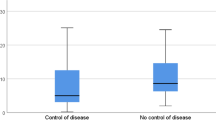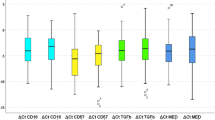Abstract
Despite recent improvements in the diagnosis and treatment, the final outcomes in patients with nasopharyngeal carcinomas (NPC) still remain suboptimal. Through data mining from published transcriptomic database with further bioinformatic validation, fibronectin (FN1) was identified as a differentially upregulated gene in NPC tissues, which implicates the transition from epithelial to mesenchymal phenotype (EMT) and promotes metastasis. Given the roles of fibronectin in risk stratification and in the frontline therapeutics of common carcinomas, such as renal cell cancer, we explored fibronectin immunoexpression status and its associations with clinicopathological variables and survival in a well-defined cohort of NPC patients. Fibronectin immunohistochemistry was retrospectively performed and analyzed using H-score for 124 biopsy specimens from NPC patients who received standard treatment without distant metastasis at initial diagnosis. Those cases with H-score higher than the median value were regarded as fibronectin overexpression. The findings were correlated with clinicopathological variables, EBV latent membrane protein 1 (LMP1) expression, disease-specific survival (DSS), distant metastasis-free survival (DMFS), and local recurrence-free survival (LRFS). Fibronectin overexpression was significantly associated with American Joint Committee on Cancer (AJCC) stages III–IV (p = 0.019) and LMP1 expression (p = 0.004), and univariately predictive of adverse outcomes for DSS, DMFS, and LRFS (all p < 0.0001). In the multivariate comparison, fibronectin overexpression still remained prognostically independent to portend worse DSS (p < 0.01, hazard ratio = 5.958), DMFS (p < 0.01, hazard ratio = 5.728), and LRFS (p < 0.01, hazard ratio = 5.411) together with advanced AJCC stages III–IV. Fibronectin is upregulated in a subset of NPCs, and its increased immunoexpression significantly correlated with advanced features, justifying the potentiality of fibronectin as a theragnostic biomaker of NPC.




Similar content being viewed by others
Abbreviations
- NPC:
-
Nasopharyngeal carcinomas
- EBV:
-
Epstein–Barr virus
- WHO:
-
World Health Organization
References
Chan JKC, Pilch BZ, Bray F, Wening BM, McCarron P, Huang D, et al. Nasopharyngeal carcinoma. In: Barnes L, Eveson JW, Reichart P, Sidransky D, editors. Pathology and genetics of head and neck tumors, WHO Classification of Tumors, vol. 9. 3rd ed. France: IARC; 2005. p. 85–97.
Raab-Traub N, Flynn K, Pearson G, Huang A, Levine P, Pagano J. The differentiated form of nasopharyngeal carcinoma contains Epstein-Barr virus DNA. Int J Cancer. 1987;39(1):25–9.
Raab-Traub N. Epstein-Barr virus in the pathogenesis of NPC. Semin Cancer Biol. 2002;12(6):431–41.
BA Carneiro, BE Brockstein, KM Stenson, S Song. Overview of treatment for head and neck squamous cell cancer. UpToDate. 2013. http://www.uptodate.com/contents/overview-of-treatment-for-head-and-neck-squamous-cell-cancer. Literature review current through: Jun 2013. This topic last update: Dec 12, 2012. Accessed
Zhang L, Zhoa C, Ghimire B, Hong MH, Liu Q, Zhang Y, et al. The role of concurrent chemoradiotherapy in the treatment of locoregionally advanced nasopharyngeal carcinoma among endemic population: a meta-analysis of the phase III randomized trials. BMC Cancer. 2010;10:558. doi:10.1186/1471-2407-10-558.
Fang FM, Chien CY, Tsai WL, Chen HC, Hsu HC, Lui CC, et al. Quality of life and survival outcome for patients with nasopharyngeal carcinoma receiving three-dimensional conformal radiotherapy vs. intensity-modulated radiotherapy-a longitudinal study. Int J Radiat Oncol Biol Phys. 2008;72(2):356–64.
Dawson CW, Port RJ, Young LS. The role of the EBV-encoded latent membrane proteins LMP1 and LMP2 in the pathogenesis of nasopharyngeal carcinoma (NPC). Semin Cancer Biol. 2012;22(2):144–53.
Yoshizaki T. Promotion of metastasis in nasopharyngeal carcinoma by Epstein-Barr virus latent membrane protein-1. Histol Histopathol. 2002;17(3):845–50.
Jia D, Entersz I, Butler C, Foty RA. Fibronectin matrix-mediated cohesion suppresses invasion of prostate cancer cells. BMC Cancer. 2012;12:94. doi:10.1186/1471-2407-12-94.
Nair KS, Naidoo R, Chetty R. Expression of cell adhesion molecules in oesophageal carcinoma and its prognostic value. J Clin Pathol. 2005;58(4):343–51.
Bae YK, Kim A, Kim MK, Choi JE, Kang SH, Lee SJ. Fibronectin expression in carcinoma cells correlates with tumor aggressiveness and poor clinical outcome in patients with invasive breast cancer. Hum Pathol. 2013;44:2028–37. doi:10.1016/j.humpath.2013.03.006.
Luo WR, Chen XY, Li SY, Wu AB, Yao KT. Neoplastic spindle cells in nasopharyngeal carcinoma show features of epithelial-mesenchymal transition. Histopathology. 2012;61(1):113–22.
Kao YC, Lee SW, Lin LC, Chen LT, Hsing CH, Hsu HP, et al. Fatty acid synthase overexpression confers an independent prognosticator and association with radiation resistance in nasopharyngeal carcinoma. Tumour Biol. 2013;34(2):759–68.
Lee SW, Chen TJ, Lin LC, Li CF, Chen LT, Hsing HP, et al. Overexpression of thymidylate synthase confers an independent prognostic indicator in nasopharyngeal carcinoma. Exp Mol Pathol. 2013;95(1):83–90. doi:10.1016/j.yexmp.2013.05.006.
Win KT, Lee SW, Huang HY, Lin LC, Lin CY, Hsing CH, et al. Nicotinamide N-methyltransferase overexpression is associated with Akt phosphorylation and indicates worse prognosis in patients with nasopharyngeal carcinoma. Tumor Biol. 2013. doi:10.1007/s13277-013-0980-z.
Edge SB, Byrd DR, Compton CC, Fritz AG, Greene FL, Trotti A. American Joint Committee on Cancer: AJCC cancer staging manual. 7th ed. New York: Springer; 2010.
Lan J, Huang HY, Lee SW, Chen TJ, Tai HC, Hsu HP, et al. TOP2A overexpression as a poor prognostic factor in patients with nasopharyngeal carcinoma. Tumor Biol. 2013. doi:10.1007/s13277-013-1022-6.
Wolden SL, Zelefsky MJ, Kraus DH, Rosenzweig KE, Chong LM, Shaha AR, et al. Accelerated concomitant boost radiotherapy and chemotherapy for advanced nasopharyngeal carcinoma. J Clin Oncol. 2001;19(4):1105–10.
Waalkes S, Atschekzei F, Kramer MW, Hennenlotter J, Vetter G, Becker JU, et al. Fibronectin 1 mRNA expression correlates with advanced disease in renal cancer. BMC Cancer. 2010;10:503. doi:10.1186/1471-2407-10-503.
Ledford H. Cancer theory faces doubts. Nature. 2011;472:273. doi:10.1038/472273a.
Zhao Y, Wang Y, Zeng S, Hu X. LMP1 expression is positively associated with metastasis of nasopharyngeal carcinoma: evidence from a meta-analysis. J Clin Pathol. 2012;65(1):41–5.
Horikawa T, Yoshizaki T, Kondo S, Furukawa M, Kaizaki Y, Pagano JS. Epstein-Barr virus latent membrane protein 1 induces Snail and epithelial-mesenchymal transition in metastatic nasopharyngeal carcinoma. Br J Cancer. 2011;104(7):1160–7. doi:10.1038/bjc.2011.38.
Kaye KM, Izumi KM, Mosialos G, Kieff E. The Epstein-Barr virus LMP1 cytoplasmic carboxy terminus is essential for B-lymphocyte transformation: fibroblast cocultivation complements a critical function within the terminal 155 residues. J Virol. 1995;69(2):675–83.
You S, Zhang F, Meng F, Li H, Liu Q, Liang Y, et al. EBV-encoded LMP1 increases nuclear β-catenin accumulation and its transcriptional activity in nasopharyngeal carcinoma. Tumour Biol. 2011;32(4):623–30.
Saito-Diaz K, Chen TW, Wang X, Thorne CA, Wallace HA, Page-McCaw A, et al. The way Wnt works: components and mechanism. Growth Factors. 2013;31(1):1–31. doi:10.3109/08977194.2012.752737. Epub 2012 Dec 21.
Endo K, Kondo S, Shackleford J, Horikawa T, Kitagawa N, Yoshizaki T, et al. Phosphorylated ezrin is associated with EBV latent membrane protein 1 in nasopharyngeal carcinoma and induces cell migration. Oncogene. 2009;28(14):1725–35. doi:10.1038/onc.2009.20.
Kaspar M, Zardi L, Neri D. Fibronectin as target for tumor therapy. Int J Cancer. 2006;118(6):1331–9.
Knowles LM, Malik G, Hood BL, Conrads TP, Pilch J. CLT1 targets angiogenic endothelium through CLIC1 and fibronectin. Angiogenesis. 2012;15(1):115–29. doi:10.1007/s10456-011-9247-8.
Carnemolla B, Borsi L, Balza E, Castellani P, Meazza R, Berndt A, et al. Enhancement of the antitumor properties of interleukin-2 by its targeted delivery to the tumor blood vessel extracellular matrix. Blood. 2002;99(5):1659–65.
Borsi L, Balza E, Carnemolla B, Sassi F, Castellani P, Berndt A, et al. Selective targeted delivery of TNFalpha to tumor blood vessels. Blood. 2003;102(13):4384–92.
Nilsson F, Kosmehl H, Zardi L, Neri D. Targeted delivery of tissue factor to the ED-B domain of fibronectin, a marker of angiogenesis, mediates the infarction of solid tumors in mice. Cancer Res. 2001;61(2):711–6.
Papadia F, Basso V, Patuzzo R, Maurichi A, Di Florio A, Zardi L, et al. Isolated limb perfusion with the tumor-targeting human monocle antibody-cytokine fusion protein L19-TNF plus melphalan and mild hyperthermia in patients with locally advanced extremity melanoma. J Surg Oncol. 2013;107(2):173–9.
Acknowledgments
This work was sponsored by Chi-Mei Medical Center (to C-F Li). The authors highly appreciated the BioBank of Chi-Mei Medical Center for providing the tumor samples.
Conflicts of interest
None.
Authors' contributions
L-J Ma, S-W Lee, T-Z Chen, and C-F Li collaborated in the conception and design of the study. K-Y Chang, H-Y Huang, and T-Z Chen developed the study methodology. L-C Lin, H-P Hsu, C-F Li acquired the data. T-J Chen, I-W Chang, and C-F Li analyzed and interpreted the data. L-J Ma, H-Y Huang, and C-F Li wrote and/or revised the manuscript. S-W Lee and C-F Li supervised the study.
Author information
Authors and Affiliations
Corresponding author
Electronic supplementary material
Below is the link to the electronic supplementary material.
ESM 1
(DOC 30 kb)
Rights and permissions
About this article
Cite this article
Ma, LJ., Lee, SW., Lin, LC. et al. Fibronectin overexpression is associated with latent membrane protein 1 expression and has independent prognostic value for nasopharyngeal carcinoma. Tumor Biol. 35, 1703–1712 (2014). https://doi.org/10.1007/s13277-013-1235-8
Received:
Accepted:
Published:
Issue Date:
DOI: https://doi.org/10.1007/s13277-013-1235-8




